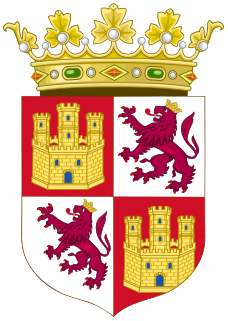Related Research Articles

Alfonso the Magnanimous was the King of Aragon and King of Sicily and the ruler of the Crown of Aragon from 1416 and King of Naples from 1442 until his death. He was involved with struggles to the throne of the Kingdom of Naples with Louis III of Anjou, Joanna II of Naples and their supporters, but ultimately failed and lost Naples in 1424. He recaptured it in 1442 and was crowned king of Naples. He had good relations with his vassal, Stjepan Kosača, and his ally, Skanderbeg, providing assistance in their struggles in the Balkans. He led diplomatic contacts with the Ethiopian Empire and was a prominent political figure of the early Renaissance, being a supporter of literature as well as commissioning several constructions for the Castel Nuovo.

John II, called the Great or the Faithless, was King of Aragon from 1458 until his death in 1479. As the husband of Queen Blanche I of Navarre, he was King of Navarre from 1425 to 1479. John was also King of Sicily from 1458 to 1468.

Charles, Prince of Viana, sometimes called Charles IV of Navarre, was the son of King John II of Aragon and Queen Blanche I of Navarre.

The Kingdom of Aragon was a medieval and early modern kingdom on the Iberian Peninsula, corresponding to the modern-day autonomous community of Aragon, in Spain. It should not be confused with the larger Crown of Aragon, which also included other territories — the Principality of Catalonia, the Kingdom of Valencia, the Kingdom of Majorca, and other possessions that are now part of France, Italy, and Greece — that were also under the rule of the King of Aragon, but were administered separately from the Kingdom of Aragon.

The Kingdom of Navarre, originally the Kingdom of Pamplona, was a Basque kingdom that occupied lands on both sides of the western Pyrenees, alongside the Atlantic Ocean between present-day Spain and France.
Galindo Aznárez II was Count of Aragon from 893 to 922. He was the son of Aznar Galíndez II and his wife Onneca Garcés, daughter of King García Íñiguez of Pamplona.

The Order of Montesa is a Christian military order, territorially limited to the old Crown of Aragon. It was named after the castle of Montesa, its headquarters.

Eleanor of Navarre, was a Navarrese princess and monarch. She served as the regent of Navarre from 1455 to 1479, during the absence of her father, and then briefly as the queen regnant of Navarre in 1479. She was crowned on 28 January 1479 in Tudela.

Blanche I was Queen of Navarre from the death of her father, King Charles III, in 1425 until her own death. She had been Queen of Sicily from 1402 to 1409 by marriage to King Martin I, serving as regent of Sicily from 1404 to 1405 and from 1408 to 1415.
The Catalan Civil War, also called the Catalonian Civil War or the War against John II, was a civil war in the Principality of Catalonia, then part of the Crown of Aragon, between 1462 and 1472. The two factions, the royalists who supported John II of Aragon and the Catalan constitutionalists, disputed the extent of royal rights in Catalonia. The French entered the war at times on the side on John II and at times with the Catalans. The Catalans, who at first rallied around John's son Charles of Viana, set up several pretenders in opposition to John during the course of the conflict. Barcelona remained their stronghold to the end: with its surrender the war came to a close. John, victorious, re-established the status quo ante.

Agnes of Cleves (1422–1448) was a daughter of Adolph I, Duke of Cleves and his second wife Mary of Valois, daughter of John the Fearless duke of Burgundy.
Galceran de Requesens y Santa Coloma, a Catalan nobleman, was an enemy of the Barcelona city council, and was Governor of Mallorca. He was a son of Luis de Requesens y Relat, baron of Altafulla and La Nou de Gaià, both rural lands located in the Spanish province of Tarragona.
Luis de Requesens y de Relat was Catalan baron of Altafulla, baron of La Nou de Gaià, both in the province of Tarragona, Spain.
John Ramon III Folch de Cardona i de Prades,, was a Catalan nobleman. John Ramon's titles included Count of Prades (4th), Count of Cardona, Viscount of Vilamur, Baron of Entença, Admiral of Aragon, Captain-general of Catalonia as well as Viceroy of Sicily from 1477 to 1479.
Peter was the son and heir apparent of Queen Maria and King Martin I of Sicily. He was a member of the House of Barcelona.
Louis of Beaumont was a noble in the Kingdom of Navarre. He was the 2nd Count of Lerín in southern Navarre, Marquis of Huesca, and Constable (condestable) of Navarre.
Violant de Prades de Gandia (1395–1471), was a Spanish noblewoman.
References
- 1 2 3 4 Vera-Cruz Miranda Menacho, El Príncipe de Viana en la Corona de Aragón (1457–1461), PhD diss. (University of Barcelona, 2011), pp. 503–12.
- ↑ Aragona, Filippo d' Dizionario Biografico degli Italiani, Volume 3 (Rome: Istituto dell'Enciclopedia Italiana, 1961).